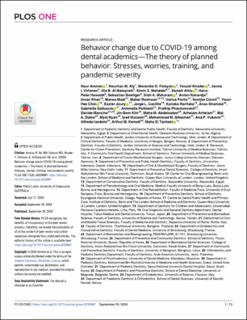| dc.contributor.author | Ammar, Nour | |
| dc.contributor.author | Aly, Nourhan M. | |
| dc.contributor.author | Folayan, Morenike O. | |
| dc.contributor.author | Khader, Yousef | |
| dc.contributor.author | Virtanen, Jorma I. | |
| dc.contributor.author | Al-Batayneh, Ola B. | |
| dc.contributor.author | Mohebbi, Simin Z. | |
| dc.contributor.author | Attia, Sameh | |
| dc.contributor.author | Howaldt, Hans-Peter | |
| dc.contributor.author | Boettger, Sebastian | |
| dc.contributor.author | Maharani, Diah A. | |
| dc.contributor.author | Rahardjo, Anton | |
| dc.contributor.author | Khan, Imran | |
| dc.contributor.author | Madi, Marwa | |
| dc.contributor.author | Rashwan, Maher | |
| dc.contributor.author | Pavlic, Verica | |
| dc.contributor.author | Cicmil, Smiljka | |
| dc.contributor.author | Choi, Youn-Hee | |
| dc.contributor.author | Joury, Easter | |
| dc.contributor.author | Castillo, Jorge L. | |
| dc.contributor.author | Noritake, Kanako | |
| dc.contributor.author | Shamala, Anas | |
| dc.contributor.author | Galluccio, Gabriella | |
| dc.contributor.author | Polimeni, Antonella | |
| dc.contributor.author | Phantumvanit, Prathip | |
| dc.contributor.author | Mancino, Davide | |
| dc.contributor.author | Kim, Jin-Bom | |
| dc.contributor.author | Abdelsalam, Maha M. | |
| dc.contributor.author | Arheiam, Arheiam | |
| dc.contributor.author | Dama, Mai A. | |
| dc.contributor.author | Nyan, Myat | |
| dc.contributor.author | Hussein, Iyad | |
| dc.contributor.author | Alkeshan, Mohammad M. | |
| dc.contributor.author | Vukovic, Ana P. | |
| dc.contributor.author | Iandolo, Alfredo | |
| dc.contributor.author | Kemoli, Arthur M. | |
| dc.contributor.author | El Tantawi, Maha | |
| dc.date.accessioned | 2021-04-15T13:29:01Z | |
| dc.date.available | 2021-04-15T13:29:01Z | |
| dc.date.created | 2020-09-30T15:24:46Z | |
| dc.date.issued | 2020 | |
| dc.identifier.issn | 1932-6203 | |
| dc.identifier.uri | https://hdl.handle.net/11250/2737956 | |
| dc.description.abstract | Objective
COVID-19 pandemic led to major life changes. We assessed the psychological impact of COVID-19 on dental academics globally and on changes in their behaviors.
Methods
We invited dental academics to complete a cross-sectional, online survey from March to May 2020. The survey was based on the Theory of Planned Behavior (TPB). The survey collected data on participants’ stress levels (using the Impact of Event Scale), attitude (fears, and worries because of COVID-19 extracted by Principal Component Analysis (PCA), perceived control (resulting from training on public health emergencies), norms (country-level COVID-19 fatality rate), and personal and professional backgrounds. We used multilevel regression models to assess the association between the study outcome variables (frequent handwashing and avoidance of crowded places) and explanatory variables (stress, attitude, perceived control and norms).
Results
1862 academics from 28 countries participated in the survey (response rate = 11.3%). Of those, 53.4% were female, 32.9% were <46 years old and 9.9% had severe stress. PCA extracted three main factors: fear of infection, worries because of professional responsibilities, and worries because of restricted mobility. These factors had significant dose-dependent association with stress and were significantly associated with more frequent handwashing by dental academics (B = 0.56, 0.33, and 0.34) and avoiding crowded places (B = 0.55, 0.30, and 0.28). Low country fatality rates were significantly associated with more handwashing (B = -2.82) and avoiding crowded places (B = -6.61). Training on public health emergencies was not significantly associated with behavior change (B = -0.01 and -0.11).
Conclusions
COVID-19 had a considerable psychological impact on dental academics. There was a direct, dose-dependent association between change in behaviors and worries but no association between these changes and training on public health emergencies. More change in behaviors was associated with lower country COVID-19 fatality rates. Fears and stresses were associated with greater adoption of preventive measures against the pandemic. | en_US |
| dc.language.iso | eng | en_US |
| dc.publisher | Public Library of Science | en_US |
| dc.rights | Navngivelse 4.0 Internasjonal | * |
| dc.rights.uri | http://creativecommons.org/licenses/by/4.0/deed.no | * |
| dc.title | Behavior change due to COVID-19 among dental academics—The theory of planned behavior: Stresses, worries, training, and pandemic severity | en_US |
| dc.type | Journal article | en_US |
| dc.type | Peer reviewed | en_US |
| dc.description.version | publishedVersion | en_US |
| dc.rights.holder | Copyright 2020 Ammar et al. | en_US |
| dc.source.articlenumber | e0239961 | en_US |
| cristin.ispublished | true | |
| cristin.fulltext | original | |
| cristin.qualitycode | 1 | |
| dc.identifier.doi | 10.1371/journal.pone.0239961 | |
| dc.identifier.cristin | 1835739 | |
| dc.source.journal | PLOS ONE | en_US |
| dc.identifier.citation | PLOS ONE. 2020, 15 (9), e0239961. | en_US |
| dc.source.volume | 15 | en_US |
| dc.source.issue | 9 | en_US |

